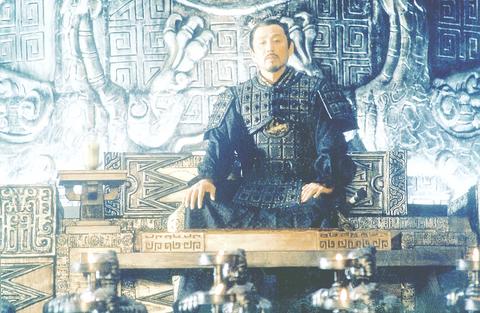The story of those who sought to stop the king of Chin from obliterating the diverse kingdoms that later became China has been told in countless books, plays, operas and films. The films on this subject have attracted China's greatest cinematic talent, but on the whole have failed to amount to much. Hero, which opens in Taiwan today, sees another of China's great directors bite the dust in dealing with this same subject.
Zhang Yimou's (

PHOTO: FOX
Hero is certainly something to look at, with two of Hong Kong's most charismatic stars, Maggie Cheung (

PHOTO: FOX
The story opens with Nameless (Jet Li), a sword fighter, entering the grand and forbidding palace of the king of Chin. The starkness of the hall represents the severity of Chin's law, and the symbolism sets the tone for the rest of the movie, which seems almost purposely to abjure any narrative warmth. Style, we are told in the opening scenes, is everything. The tricks that Zhang first used in Raise the Red Lantern (
And Zhang hasn't gone for anything as mundane as historical accuracy in his first costume epic. There is lots of floating gauze and creatively designed weapons, and the Chin soldiers are subjected to the indignity of shooting off their bows with their feet while sitting on the ground, which Zhang has confessed has absolutely no basis in history. But it may be thought exotic by Western audiences.

PHOTO: FOX
The film's structure follows Akira Kurosawa's classic Rashomon (1950) in that it goes over the same ground a number of times from different perspectives -- in this case, a battle of wits between Nameless and the king as to how Nameless managed to kill off Sky (
Unfortunately you never really care which of the versions presented is the true one because the director fails from the beginning to establish any empathy with the characters.
Which leads to the crucial issue of Zhang's resolution to his martial arts epic. Part of the uniqueness of his approach is that he violates many of the fundamental principles of the chivalric hero character -- apolitical, self-interested, care-free -- in order to achieve a grander vision, which unfortunately pulls the carpet out from under the feet of his "heroes," leaving them looking merely foolish. The end result is not an achievement of some higher state of heroism, but defeat at the hands of a tougher operator. For martial arts movie fans, it is all very unsatisfactory.
A long exposition about the character "sword," written by Broken Sword and presented to the king by Nameless, only goes further to underline the political and philosophical chaos that Zhang has become embroiled in, but he seems content to allow the Chinese "culture" of the whole thing to override any need for logical coherence.
Zhang's attempt to transform the selfish individualism of martial arts fighters into a superficial universal love kills all the glamor and fascination of the chivalric spirit. The freedom that characters like Nameless, Snow and Broken Sword are supposed to represent gets all twisted up into a tool of a political exposition.
But all this does not become clear until late in the film, which gets bogged down in its Rashomon structure, telling and retelling the story, leaving very little room for character development. This superficiality is embodied in the character of Moon, played by Zhang Ziyi, who is little more than a face and a clothes rack.
Unfortunately, this is almost the case with Tony Leung and Maggie Cheung as well. Fans of In the Mood for Love can only feel pity for the two great actors wasting their talent on such two-dimensional characters.
The most impressive acting is done by Chen Daoming (
The final scene, showing the king's greatest achievement, the building of the Great Wall -- and all it represents -- can only make one laugh at its total lack of subtlety.
Not only has Zhang compromised the spirit of the chivalric hero, he seems to have compromised his own integrity as well.

May 26 to June 1 When the Qing Dynasty first took control over many parts of Taiwan in 1684, it roughly continued the Kingdom of Tungning’s administrative borders (see below), setting up one prefecture and three counties. The actual area of control covered today’s Chiayi, Tainan and Kaohsiung. The administrative center was in Taiwan Prefecture, in today’s Tainan. But as Han settlement expanded and due to rebellions and other international incidents, the administrative units became more complex. By the time Taiwan became a province of the Qing in 1887, there were three prefectures, eleven counties, three subprefectures and one directly-administered prefecture, with

It’s an enormous dome of colorful glass, something between the Sistine Chapel and a Marc Chagall fresco. And yet, it’s just a subway station. Formosa Boulevard is the heart of Kaohsiung’s mass transit system. In metro terms, it’s modest: the only transfer station in a network with just two lines. But it’s a landmark nonetheless: a civic space that serves as much more than a point of transit. On a hot Sunday, the corridors and vast halls are filled with a market selling everything from second-hand clothes to toys and house decorations. It’s just one of the many events the station hosts,

Two moves show Taichung Mayor Lu Shiow-yen (盧秀燕) is gunning for Chinese Nationalist Party (KMT) party chair and the 2028 presidential election. Technically, these are not yet “officially” official, but by the rules of Taiwan politics, she is now on the dance floor. Earlier this month Lu confirmed in an interview in Japan’s Nikkei that she was considering running for KMT chair. This is not new news, but according to reports from her camp she previously was still considering the case for and against running. By choosing a respected, international news outlet, she declared it to the world. While the outside world

Through art and storytelling, La Benida Hui empowers children to become environmental heroes, using everything from SpongeBob to microorganisms to reimagine their relationship with nature. “I tell the students that they have superpowers. It needs to be emphasized that their choices can make a difference,” says Hui, an environmental artist and education specialist. For her second year as Badou Elementary’s artist in residence, Hui leads creative lessons on environmental protection, where students reflect on their relationship with nature and transform beach waste into artworks. Standing in lush green hills overlooking the ocean with land extending into the intertidal zone, the school in Keelung